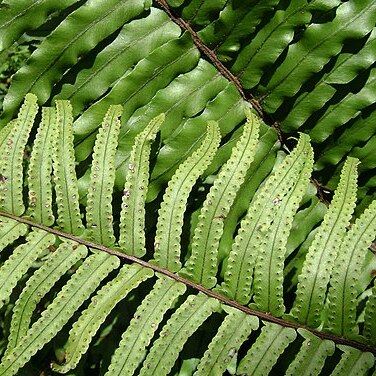Stolons and basal portions of stipes densely scaly; scales lanceolate, either pale brown or red-brown with pale margins, and bearing few to many short or long marginal cilia. Fronds to 1.2 m long; rachis with dense rusty scales consisting of a small base giving rise to many short hair-like processes and 1 elongate branch with marginal cilia. Pinnae closely spaced, usually with an elongate narrowly triangular basal auricle. Sterile pinnae 20-110 mm long, 10-20 mm wide, with scattered scales; upper midrib covered with scales or simple hairs; margins crenate towards acute apex (except in basal pinnae). Fertile pinnae 35-115 mm long, 5-14 mm wide; margins more deeply crenate. Sori submarginal; indusium reniform.
A coarse fern with creeping rootstocks. It keeps growing from year to year and forms dense colonies. The stem is erect producing a tuft of fronds. The stalks are 10-40 cm long and pale brown. The fronds are narrow with leaflets. The fronds are 0.3 to 1.2 m long and 8 to 15 cm wide. They are erect or arch over. The leaflets are 5-10 cm long by 1-2 cm wide. The base has a narrow, triangle shaped lobe. There are rounded teeth along the edge. The plant grows both on the ground and on other plants. It is smaller than Nephrolepis biserrata. The fertile leaflets are more narrow than the sterile ones. The spore bodies or sori are near the edge of the leaf.
Rhizomes creeping to erect, scaly, with numerous far-creeping runners. Stipes much < laminae. Stipes and rachises pale brown, brittle, bearing dark appressed fimbriate scales. Laminae elliptic to narrowly elliptic, 30-200 × 10-25 cm, pinnate. Primary pinnae in > 40 pairs, overlapping in middle of frond, more widely spaced at base, the longest 5-15 × 0.8-1.6 cm, with undersurfaces covered in scales with fimbriate margins, falcate with a basal acroscopic lobe, tapering to acute apices; margins irregularly crenate or serrate especially near apex. Sori round, in single rows near margins of pinnae, protected by reniform indusia.

